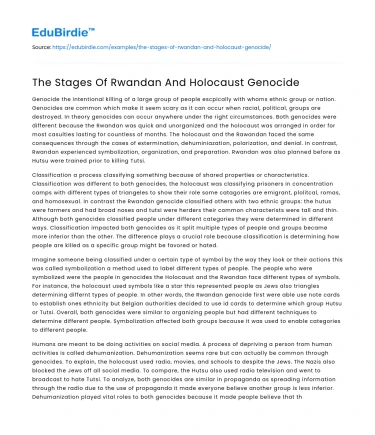Introduction
The Rwandan Genocide of 1994 and the Holocaust during World War II stand as two of the most harrowing instances of systemic mass murder in modern history. Both events unfolded through recognizable stages, highlighting a progression from discrimination and dehumanization to organized extermination. Although separated by decades and differing in geographical, cultural, and political contexts, the genocides share chilling similarities in their execution strategies. By examining these events through the lens of genocide theory, specifically the eight stages of genocide posited by Gregory Stanton, we gain critical insights into the mechanisms of mass violence. This essay will explore these stages in relation to the Rwandan Genocide and the Holocaust, illustrating the processes that transformed societal tensions into catastrophic loss of life. Additionally, it will address counter-arguments concerning the applicability of genocide stages to different historical contexts, thereby enriching our understanding of the factors that facilitate such tragedies.
Classification and Symbolization
Classification and symbolization are the initial stages of genocide, where societal divisions are accentuated, often leading to the creation of an "us versus them" mentality. In the Holocaust, the Nazi regime meticulously classified individuals based on race, political beliefs, and physical disabilities. Jews were symbolized by the yellow Star of David, a stark emblem of their ostracization. As noted by historian Yehuda Bauer, this classification laid the groundwork for systematic persecution: "It was not the German people who decided they should kill the Jews, it was the Nazis who decided, and they had the power to enforce their decision." Similarly, in Rwanda, the colonial legacy of Belgian rule entrenched ethnic identities, primarily between the Hutus and Tutsis. Identification cards signifying ethnicity were implemented, fostering division. This artificial hierarchy was pivotal in escalating tensions, as it provided a basis for discrimination that would later spiral into violence.
Save your time!
We can take care of your essay
- Proper editing and formatting
- Free revision, title page, and bibliography
- Flexible prices and money-back guarantee
Transitioning from classification to the subsequent stages, it is crucial to understand that these identifiers do not inherently lead to genocide. However, they become dangerous when manipulated by those in power to cultivate an environment conducive to hatred and violence. The symbolization stage, while seemingly benign, proves lethal as it facilitates the dehumanization of the target group, making the unthinkable acts of genocide conceivable.
Dehumanization and Organization
Dehumanization is a critical precursor to genocide, where the victim group is stripped of their humanity, often through propaganda that likens them to vermin or diseases. In Germany, the Nazi propaganda machine was relentless, portraying Jews as subhuman and a threat to Aryan purity. This dehumanization was a strategic move to erode empathy from the general populace and justify the ensuing brutality. In Rwanda, Tutsi were referred to as "cockroaches" over radio broadcasts, a chilling tactic that normalized violence against them. As noted by Jean Hatzfeld in his book "Machete Season," this rhetoric was instrumental: "The language of extermination was woven into everyday communication, priming neighbors to turn against each other."
Organization, the fourth stage, involves the systematic planning of genocide. During the Holocaust, the Wannsee Conference of 1942 exemplified this, where Nazi officials coordinated the logistics of the "Final Solution." In Rwanda, the organization phase was marked by the arming and training of Hutu militias, such as the Interahamwe, with explicit instructions to kill Tutsis. This stage underscores the chilling reality that genocide is not a spontaneous eruption of violence but a calculated, orchestrated campaign.
As we transition to the following stages, it becomes evident that the preceding dehumanization and organization lay the groundwork for the subsequent acts of mass violence. The meticulous planning involved starkly contrasts with the chaos that ensues, demonstrating the duality of genocide as both structured and anarchic.
Extermination and Denial
The penultimate stage, extermination, is where the genocidal goals manifest in acts of mass murder. The Holocaust saw the establishment of extermination camps like Auschwitz, where millions of Jews, Romani people, and others were systematically killed. This stage was characterized by its industrial scale and efficiency, a grim testament to the extent of Nazi dehumanization and planning. In Rwanda, the genocide was swift and brutal, with an estimated 800,000 Tutsis and moderate Hutus killed within 100 days. The use of machetes and local participation highlighted the personal nature of the violence, contrasting with the impersonal mechanisms of the Holocaust.
The final stage, denial, involves the perpetrators' refusal to acknowledge the genocide, often by destroying evidence and shifting blame. In post-war Germany, denial took the form of Holocaust denial movements, despite overwhelming evidence. In Rwanda, some perpetrators fled to neighboring countries, continuing to propagate narratives that minimized or justified the genocide. Denial is a critical stage as it impedes justice and reconciliation, allowing the seeds of future conflicts to remain.
The examination of extermination and denial underscores the importance of international intervention and accountability. These stages reveal not only the depths of human cruelty but also the resilience of truth and justice in the face of denial and revisionism.
Conclusion
The Rwandan Genocide and the Holocaust exemplify the tragic trajectory of genocide, from classification to extermination and denial. By understanding these stages, we are better equipped to recognize and prevent future atrocities. The similarities between these events, despite their distinct contexts, highlight universal patterns in the anatomy of genocide. While the eight stages provide a framework, it is crucial to consider the unique historical, cultural, and political factors at play. Counter-arguments concerning the rigidity of these stages remind us that genocide is a complex phenomenon, requiring nuanced analysis and intervention strategies. Ultimately, the lessons from Rwanda and the Holocaust serve as a somber reminder of the vigilance required to safeguard human rights and dignity worldwide.






 Stuck on your essay?
Stuck on your essay?

